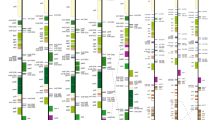Abstract
The sieve-element plastids of 85 species of the Ranunculanae were investigated by transmission electron microscopy. All contained form-Ss plastids. The average diameter of the sieve-element plastids from stem phloem is with 1.62 μm rather large, both compared to other superorders and to the dicotyledon average. Among the five families recognized in the Ranunculales (incl. Papaverales), Lardizabalaceae and Menispermaceae contain the largest average diameters (above 1.9 μm) while those of Berberidaceae, Ranunculaceae, and Papaveraceae are about 1.5 μm. Within the families there is considerable size variation which permits the inclusion of segregate taxa, even if their plastid diameter is much different from the family average (e.g., Hydrastis). Nelumbo nucifera (Nelumbonales) contains form-Ss plastids that are very similar to those of the Ranunculales. — Dispersive P-protein is a common feature found in the sieve elements of all taxa studied. Nondispersive protein bodies are recorded for Clematis and Nelumbo only.
Sieve-element plastids, phloem proteins, and the evolution of the flowering plants, V. — For previous parts in this series see (IV.:) Behnke (1989) and (III.:) Behnke (1988).
Access this chapter
Tax calculation will be finalised at checkout
Purchases are for personal use only
Preview
Unable to display preview. Download preview PDF.
Similar content being viewed by others
References
Behnke, H.-D., 1971: Sieve-tube plastids of Magnoliidae and Ranunculidae in relation to systematics. — Taxon 20: 723–730.
— 1972: Sieve-tube plastids in relation to angiosperm systematics — an attempt towards a classification by ultrastructural analysis. — Bot. Rev. 38: 155–197.
— 1975: The bases of angiosperm phylogeny: Ultrastructure. — Ann. Missouri Bot. Gard. 62: 647–663.
— 1977: Transmission electron microscopy and systematics of flowering plants. — Pl. Syst. Evol. [SuppL] 1: 155–178.
— 1981a: Siebelement-Plastiden, Phloem-Protein und Evolution der Blütenpflanzen: II. Monokotyledonen. — Ber. Deutsch. Bot. Ges. 94: 647–662.
— 1981b: Sieve-element characters. — Nordic J. Bot. 1: 381–400.
— 1982: Sieve-element plastids, exine sculpturing and the systematic affinities of the Buxaceae. — Pl. Syst. Evol. 139: 257–266.
— 1988: Sieve-element plastids, phloem protein and evolution of flowering plants: III. Magnoliidae. — Taxon 37: 699–732.
— 1989: Sieve-element plastids, phloem-proteins and the evolution of flowering plants. IV. Hamamelidae. — In Blackmore, S., Crane, P. R., (Eds): Systematics, evolution and fossil history of the Hamamelidae, 1, pp. 105–128. — Syst. Ass. Spec. Vol. 40A. Oxford: Clarendon.
— 1991a: Nondispersive protein bodies in sieve elements: a survey and review of their origin, distribution and taxonomic significance. — IAWA Bull. n.s. 12: 143–175.
— 1991b: Distribution and evolution of forms and types of sieve-element plastids in the dicotyledons. — Aliso 13: 167–182.
— 1994a: Sieve-element plastids: Their significance for the evolution and systematics of the order. — In Behnke, H.-D., Mabry, T. J., (Eds): Caryophyllales. Evolution and systematics, pp. 87–121. — Berlin, Heidelberg, New York: Springer.
— 1994b: Sieve-element plastids, nuclear crystals and phloem proteins in the Zingiberales. — Bot. Acta 107: 3–11.
Cronquist, A., 1988: The evolution and classification of flowering plants. 2nd edn. — Bronx: New York Botanical Garden.
Dahlgren, G., 1989: The last Dahlgrenogram — system of classification of the dicotyledons. — In Kit Tan, (Ed.): The Davis and Hedge Festschrift, pp. 249–260. — Edinburgh: Edinburgh University Press.
Esau, K., 1975: The phloem of Nelumbo nucifera Gaertn.-Ann. Bot. (London) 39: 901–913.
Kubitzki, K., Rohwer, J. G., Bittrich, V., (Eds), 1993: The families and genera of vascular plants, 2: Flowering plants. Dicotyledons. — Berlin, Heidelberg, New York: Springer.
Takhtajan, A., 1987: Systema Magnoliophytorum. — Leningrad: Nauka (in Russian).
Author information
Authors and Affiliations
Editor information
Editors and Affiliations
Rights and permissions
Copyright information
© 1995 Springer-Verlag Wien
About this paper
Cite this paper
Behnke, HD. (1995). Sieve-element plastids, phloem proteins, and the evolution of the Ranunculanae . In: Jensen, U., Kadereit, J.W. (eds) Systematics and Evolution of the Ranunculiflorae. Plant Systematics and Evolution Supplement 9, vol 9. Springer, Vienna. https://doi.org/10.1007/978-3-7091-6612-3_3
Download citation
DOI: https://doi.org/10.1007/978-3-7091-6612-3_3
Publisher Name: Springer, Vienna
Print ISBN: 978-3-7091-7361-9
Online ISBN: 978-3-7091-6612-3
eBook Packages: Springer Book Archive




